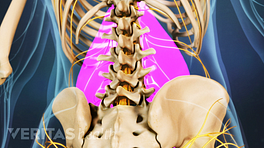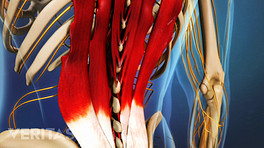If you experience a back muscle spasm, it's important that you stop and listen to your body. Either your body is telling you not to do a certain activity ever again, or it's warning you about a serious, underlying issue with your spine.
Two common causes of back muscle spasms.
The first reason is that your muscles are trying to protect themselves from muscle strain. A back spasm can occur after any type of strain or injury to your soft tissues or the muscles, tendons, and ligaments in your spine. Thankfully, back muscle spasms caused by muscle strain, will typically calm down in about a week.
Another reason your muscles may spasm is in response to an underlying anatomical problem. If your back spasm doesn't get better in 1 to 2 weeks, or if the spasm flares up periodically in the same area of your back, you may have an underlying anatomical problem. Examples of underlying issues that can cause your back to spasm include, facet joint osteoarthritis, degenerative disc disease, spinal stenosis. If you have an underlying anatomical problem, your muscle may react to the pain and inflammation by spasming. In this case, it's a good idea to seek medical attention to both treat your acute pain and to address the underlying cause of your symptoms.
First aid for a painful back muscle spasm.
When your back muscle spasms, the first step is to relieve your intense pain by finding a way to relax your muscle. This may be accomplished by one of the following treatments.
Muscle relaxants. These are prescription medications that do not directly target your muscles. Rather, they have an overall relaxing effect on your body. Muscle relaxants are typically prescribed if there is intense acute pain, and only on a short term basis.
Cold therapy. Applying ice or a gel pack to the injured part of your back, can help relieve an acute flare-up of pain. You can use a commercial ice pack or make one yourself. For example, you can put dishwasher detergent or a wet towel into a plastic bag, add some water to smooth out the lumps, double bag to prevent leaking, cover it in a towel to protect your skin from ice burns, and apply it to the painful area of your back for 15 to 20 minutes.
Reduce the stress on your back. For severe muscle spasms, you may find movement is painful and you need to rest. When you rest, you can reduce stress on your lower back, by lying on your back in bed with your upper body supported at a slight incline and with a pillow propped under your knees. If your spasm has occurred as a result of an overuse injury or muscle strain, these measures will help get you through the time it takes for your muscles to heal. On the other hand, if your spasm is in response to an underlying spine or disc dysfunction, these treatments may help alleviate your pain, but the underlying cause of the problem will still need to be addressed.
Whatever the cause of your back muscle spams, after the acute pain has resolved, you will want to consider physical therapy as this will give you the best chance of avoiding future flare-ups of pain. Listening to what your back spasm is telling you can go a long way towards helping you avoid activities that lead to spams or identifying the underlying anatomical cause of your spasms.
Thanks for watching. And as always, stay healthy.
In This Article:
- What Is Your Back Muscle Spasm Telling You?
- First Aid for Intense Pain from a Pulled Lower Back Muscle
- Video: What Is Your Back Muscle Spasm Telling You?









